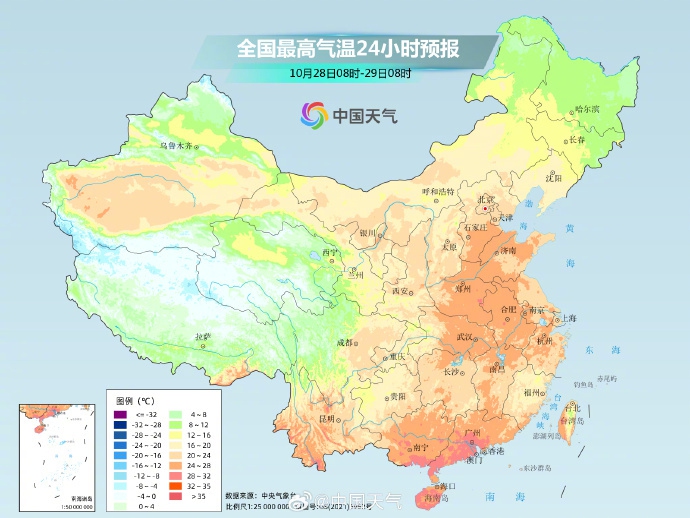Beijing records second hottest October in 60 years, with global warming contributing to weather change: meteorologists

Temperatures across several regions in China are generally at higher-than-usual levels for this time of year, with maximum temperatures in many areas possibly reaching close to 30 C. Cities such as Taiyuan, Xi'an, Shijiazhuang, Jinan, and others may experience warmth in early November that could break local records for the highest temperatures in November. Photo: Sina Weibo
The average temperature in Beijing in late October was 14.5 C, 3.4 C higher than the same period in the past, and became the highest in the history of the same period since 1961, the Beijing Meteorological Observatory said on Wednesday. Experts explained that the narrowing temperature difference between the north and the south caused by global warming was an important reason for the cold air to be difficult to reach.Meteorologists indicate the intensity of the cold air is significantly weaker than usual, and at the same time, the horizontal atmospheric circulation in the mid-latitude region has caused subsidence warming, which has kept the temperature in Beijing significantly higher since late October.
On the other hand, the weather is clear and sunny under this circulation situation, which is conducive to the warming of solar radiation and an important reason behind the rise in temperature.
In fact, not only Beijing, but the whole of northern China experienced significant high temperatures in late October this year. The average temperature of Beijing's neighboring city Tianjin hit 16.2 C as of October 28, the second highest for the same period since 1961.
"Strong north winds at this time of year usually bring cold air from the north down, cooling much of the country," Zhang Mingying, a Beijing-based meteorologist, told the Global Times on Wednesday, adding that northern China, including Beijing, have more east and west winds and less north and south winds, which means that the atmospheric circulation is flatter and there is less cold air to cool down.
Since October, the area west of Lake Baikal in the upstream of Beijing has been controlled by a high pressure ridge for an extended period. In late October, the high pressure ridge began to move eastward, making the area over Beijing controlled by a high pressure ridge.
Generally speaking, the cold air has begun to enter the active period in mid-to-late October, especially in the northern part of the country, affected by the active cold air moving south from the north, the temperature will drop significantly compared with the previous period, said Fang Chong, chief forecaster of Central Meteorological Observatory.
However, due to the weak cold air this year, the temperature is significantly higher. As of October 27, a total of 237 national weather stations have broken the historical maximum temperature in late October, which is relatively rare.
In addition, experts also stressed that the air pollution in North China in recent days is also to wait until the arrival of the next cold air to completely dissipate, and the relatively stable atmospheric circulation in recent days also means that the diffusion of air pollution conditions remain poor.
Extended high temperatures in northern China in November cannot be called extreme weather, but overall it is closely related to global climate change, Zhang noted. "The decreasing temperature difference between north and south caused by global warming is one of the important reasons for the weakening of atmospheric circulation," he continued.
Climate warming in the have accelerated over the past 40 years, with the overall warming rate 3.7 times that of the world over the same period, according to the Annual Report on Polar Climate Change 2022 released by the China Meteorological Administration on Thursday.
Polar Regions, the extensive icy regions around the North and South Poles, is a sensitive area and amplifier of global ecological change, and the changes in its climate and atmospheric environment will have an impact on the weather and climate of the globe and the sustainable development of the economy.
The Arctic has accelerated its warming over the past 40 years, with the overall warming rate reaching 0.63 C /10 years during 1979-2022, 3.7 times the global warming rate of 0.17 C /10 years during the same period, according to the report.
According to a notice issued by China's National Climate Center (NCC), China has recorded an average of 4.1 days this year where the temperature exceeded 35 C, the highest number since records began in 1961. Within the northern region, capital city Beijing has been the most severely affected, followed by the neighboring Hebei Province and Tianjin Municipality.
From June 21 to 23, more than 22 weather observatory points in North China recorded historically high temperatures, and a total of 450,000 square kilometers of land experienced temperatures exceeding 37 C in recent days. Beijing recorded consecutive days of temperatures over 40 C in June, the NCC noted.

